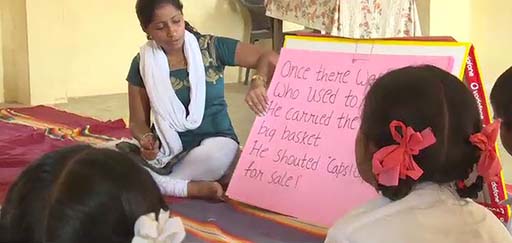3 Making and using a big book
In the next activity you will make a big book of the text you have chosen.
Activity 3: Making a big book – a planning activity
This is an activity for you to do in preparation for your lesson.
A big book with large text and illustrations is a good resource that is easy for students to follow. Students also enjoy making their own big books, either copying and illustrating a story they like or creating their own story or poem.
You can use a big book with the whole class, or you can give a big book to a group and assign one or two able or older students to lead the reading.
- Take the text you selected for shared reading in Activity 2.
- Break the text into chunks of two to three sentences.
- Copy each of these chunks in large writing onto pieces of paper. Do not write more than two to three sentences on one sheet of paper.
- Illustrate each sheet appropriately. You can also stick pictures on it or ask the students to do the illustrations.
- Design an attractive cover page for a story, or invite the students to do this after they read the story.
- Pin/tie together all the sheets along with the cover page.
You can make a simple stand for your big book out of recycled materials.
Look at the teacher with her students in Figure 3. She has made a simple stand for the big book out of cardboard.

Activity 4: Using your big book with your students
Now practise reading the big book aloud, slowly and clearly. Read with enthusiasm and expression. Record yourself if possible (you could use your mobile phone for this purpose), or read aloud in front of a colleague or a member of your family.
Point with your hand or a stick to each word as you read. Move your hand or the stick just under the words, so that students will be able to see each word as you read.
Make a list of any vocabulary that you want to introduce to students before reading the story or poem aloud. How will you introduce these words? Will you use picture cards, Hindi or the local language to explain their meaning? Note any specific language points you want to focus on, such as:
- character descriptions
- letters and sounds
- rhyming words
- new vocabulary
- reinforcing word recognition
- sentence structures and grammar
- new concepts.
Think about how you will introduce the text and organise students for the reading.
Identify points in the text where you can stop and ask students to predict a word or a rhyme, or what will happen next.
Think about how you will evaluate students’ understanding after the reading.
Try out your big book in a shared reading session with the whole class or in small groups across the week. Did your students enjoy the activity? Did you enjoy using the big book? Could all the students hear you and see the big book?
An effective way to assess students’ comprehension is to have them re-tell the text. Students can do this in pairs or small groups, as well as individually. This gives students opportunities to practise speaking English. Older and more competent students can write about their understanding.
2 Selecting a text for shared reading
